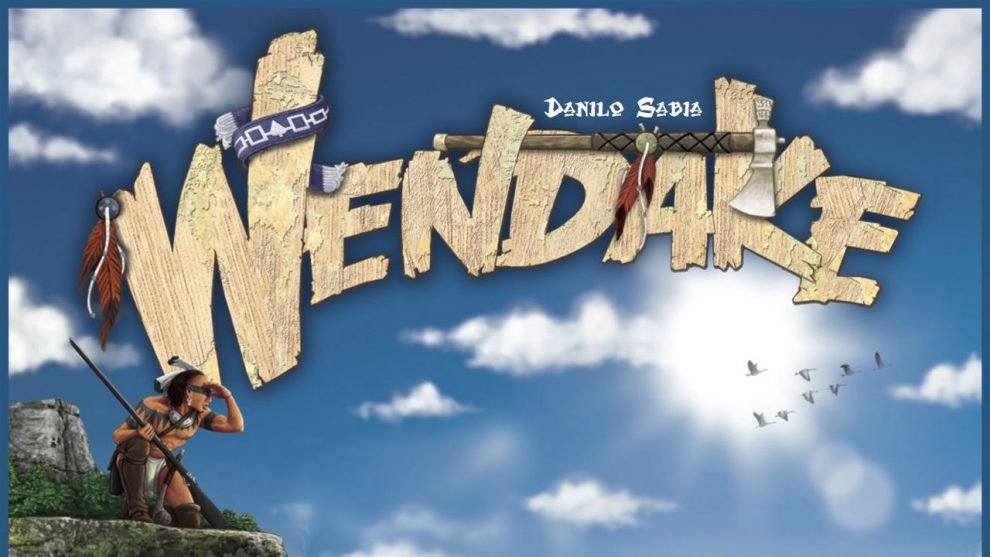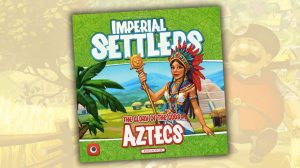Disclosure: Meeple Mountain received a free copy of this product in exchange for an honest, unbiased review. This review is not intended to be an endorsement.
Overview
In the game of Wendake players take on the roles of tribal chieftains in the United States in the mid 1700s, during the time of the Seven Years’ War between England and France, as they work to increase their tribe’s presence and influence within the region.
The game uses a unique action selection system to achieve these goals. Each player has their own player board which is composed of 9 tiles depicting different actions that they can perform—actions such as hunting, fishing, trading, exploring, and farming for instance. On their turn, a player will select one of the actions in their display to perform and then place a marker on top of the action to show that it has been selected. On the next go round, they will select a second action followed by a third on the go round after that. However, the players can’t just choose any actions willy-nilly. Instead, the three actions all have to be in the same line either horizontally, vertically, or diagonally. Then, at the end of the action selection phase, the bottom three actions will fall out of their displays and the players will be able to choose from a selection of upgraded action tiles to replace one of the removed tiles with. The newly chosen tile and the two remaining ones are shuffled and then placed back into the display in the top row.
The game is played in this way over the course of several rounds and then it comes to an end. There are four different scoring tracks that are divided randomly into pairs. Different actions will cause the scoring markers to move on one or more of these tracks throughout the course of the game. The players’ final score will be the sum of the lowest score from these two pairings so it behooves the players to strive to maintain a balance between the different scoring areas. The person with the highest score wins the game.
Now, if you’re only interested in hearing what I think about Wendake, then feel free to skip ahead to the Thoughts section. For the rest of you…
Setup
After setting up the game, you will see something that looks like this:
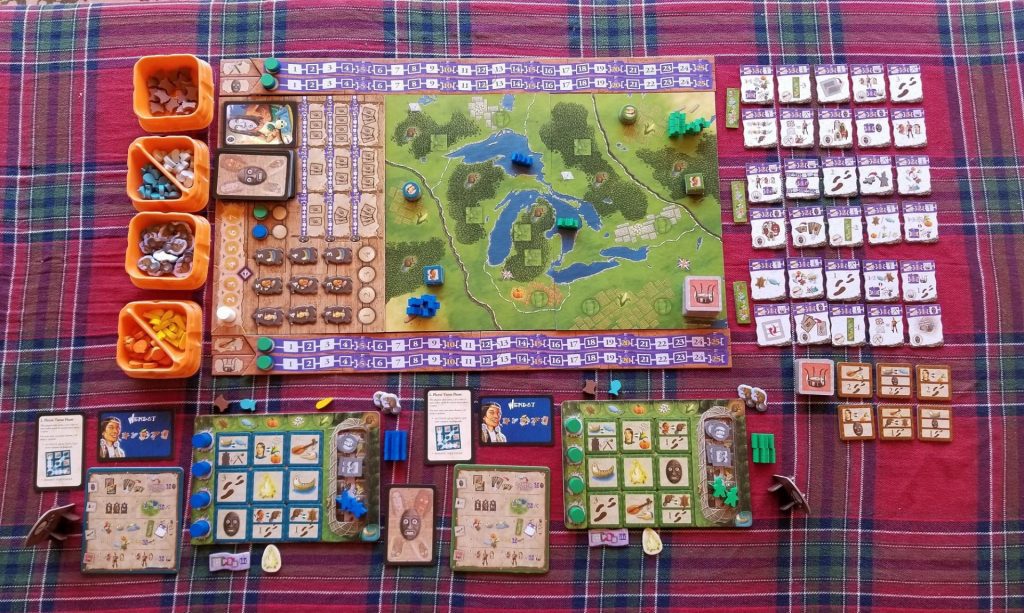
Each player begins the game with some of their pieces on the main playing board as well as a player board in front of them containing their starting goods and their starting action tile setup. Next to the main playing board is the Mask board which is seeded with the turtle tokens and a deck of mask cards with one mask turned face up. Each player will also have one of their markers placed onto this board.
Above and below the main board are the score tracks. Each score track contains a randomly selected pairing of scoring criteria. Players place their score markers on each of these tracks. The Progress tiles are arranged by level and placed close by as are the first few Advanced action tiles. Once everything’s been set up, a starting player is chosen and the player order tokens are passed out accordingly. You are now ready to begin.
Round Overview
One round of Wendake is equal to one year and involves each player taking turns either choosing and performing an action from their player board or placing one of their markers onto the turn order track. When choosing an action from their player board, there is one restriction that must be followed: the chosen action must be either orthogonally or diagonally situated to a previously selected action such that the chosen actions are all in a straight line after 3 turns.
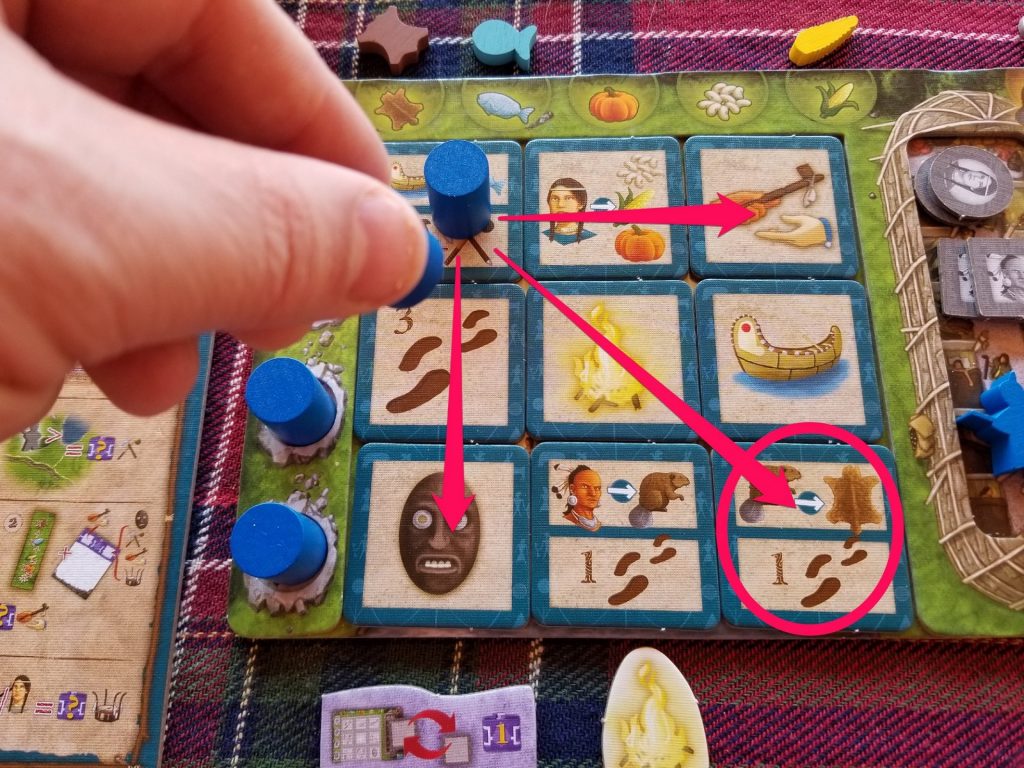
After each player has completed their three turns, the “restore” phase begins. First, the player order is adjusted according to the turn order track on the Mask board. Then each action tile that was selected is flipped to its opposite side and the bottom 3 action tiles fall off of the players’ boards. Then, in player order, each player may replace one of the removed tiles with one of the Advanced action tiles (refilling the Advanced action tiles whenever one is removed from the display). The tile that was replaced is set aside and the newly selected tile is shuffled with the two remaining tiles and these are randomly placed face up into the first line of the player board. Then a general cleanup is performed and the Year marker advances to the next year.
The Scoring Tracks
There are four different scoring tracks in Wendake: Trade, Mask Ceremony, Ritual, and Military and movement along each track happens in different ways.
Trade: this action allows you to trade resources for other resources and then you can spend resources to purchase a Progress tile. This newly acquired tile will automatically move your marker along both the Trade track as well as another track a certain number of spaces. You can also send up to 5 different resources from your personal supply to the general supply and move an equal number of spaces along the Trade track.
Mask Ceremony: this action allows you to add a Mask card to your hand either from the draw deck or the face up discard pile. After adding the mask, you may then reveal a set of masks from your hand that matches one of the set illustrations on the board. Then your marker is placed on top of the set you just created which will prevent anyone else from revealing that set as long as your marker remains there. In general, harder to create sets will result in more movement along the Mask Ceremony track than easier ones. Progress tile purchases may also cause movement along this track.
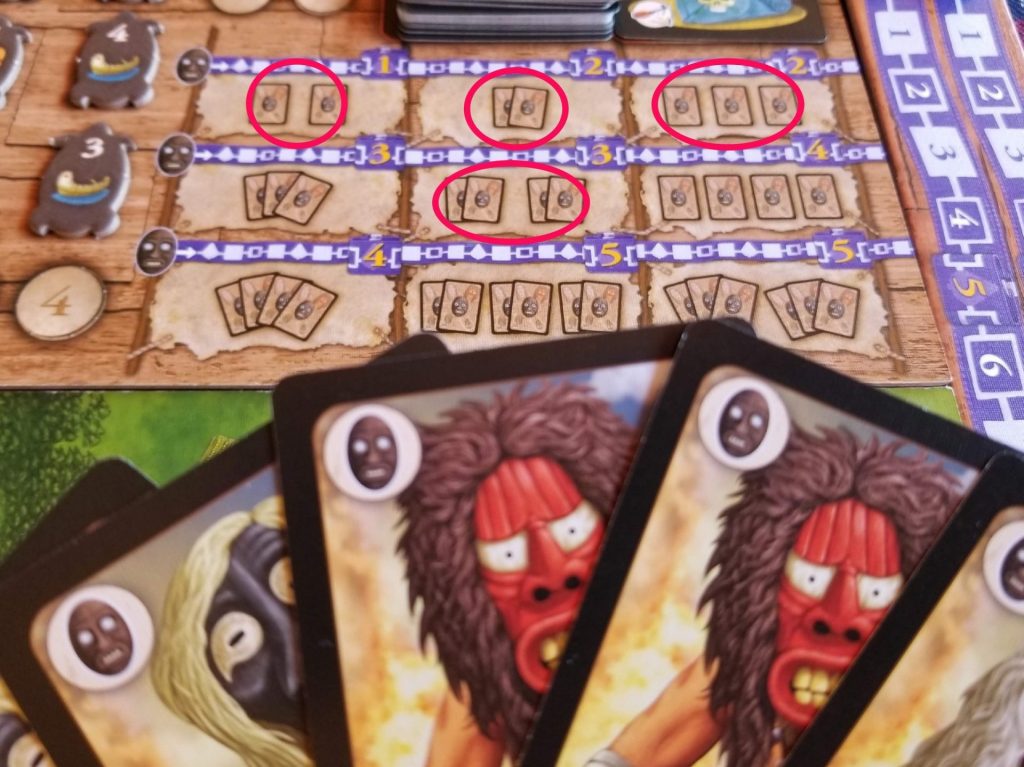
Ritual: this action allows you to move natives from your long house to your home territory. Points are then scored based on the type of native you have the fewest of (hunters, farmers, or warriors) in your home territory after the transfer is completed. Progress tile purchases may also cause movement along this track.
Military: this action allows you to claim turtle tiles which can be used, at end of the game, to score movement along whichever track is printed on the back of the tile. These tiles depict a number of hunters, canoes, or farmers on them and the players can claim any whose criteria they can meet.
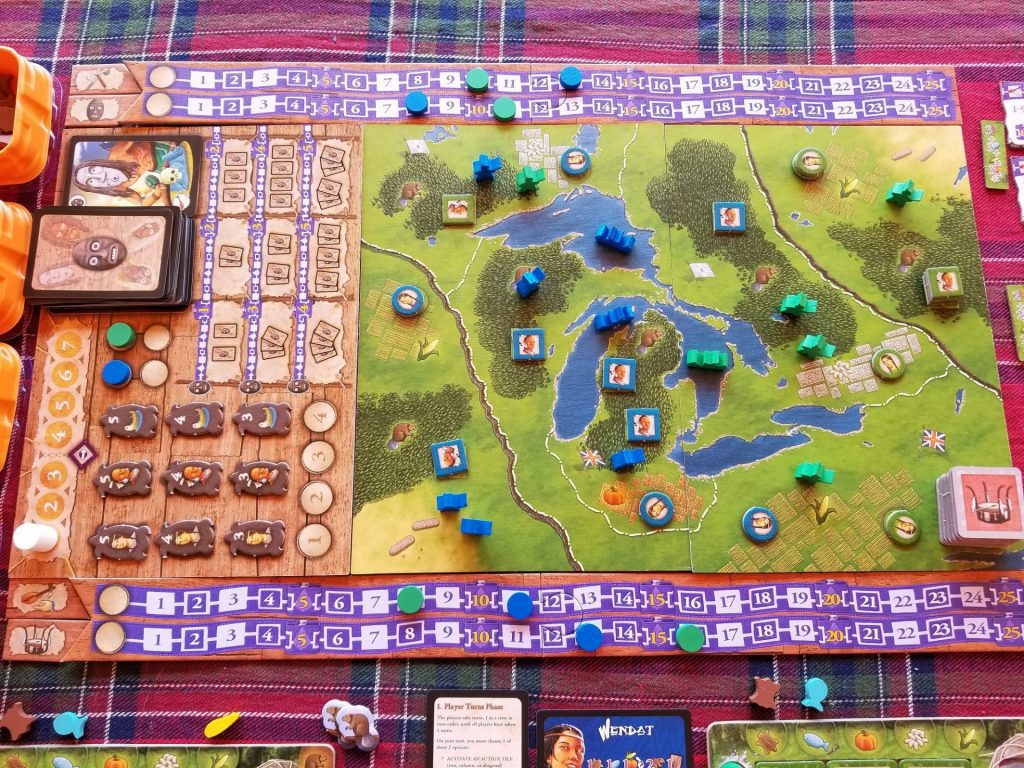
After claiming any turtle tiles, the player then scores points along the track equal to however many territories on the main board in which they have the majority of warriors. Progress tile purchases may also cause movement along this track.
Endgame
At the end of the 7th year, each player considers each of the different scoring track pairings. Their end score will be equal to the sum of the lowest total from each of these pairings. Whoever has the highest score then wins the game. In the case of a tie, the victor is the person who was earliest in the turn order.
Thoughts
How abstract is too abstract? Is it possible to abstract something so much that it loses its meaning entirely? These are questions that I ask myself when playing Wendake.
It’s no secret that the treatment of the indigenous peoples of the Americas during the age of colonialism was, to put it lightly, abhorrent. Wendake takes place at the dawn of this age and the interactions with the non-natives is largely non-existent, but it isn’t ignored entirely. If you would convert resources during the trading action, you must flip over a card from the Mask card deck to determine whether or not you received a smallpox laden blanket from those with whom you traded. If the card turns up a skull, then you must remove one of your natives from the board and place them into your long house, a mild annoyance at best.
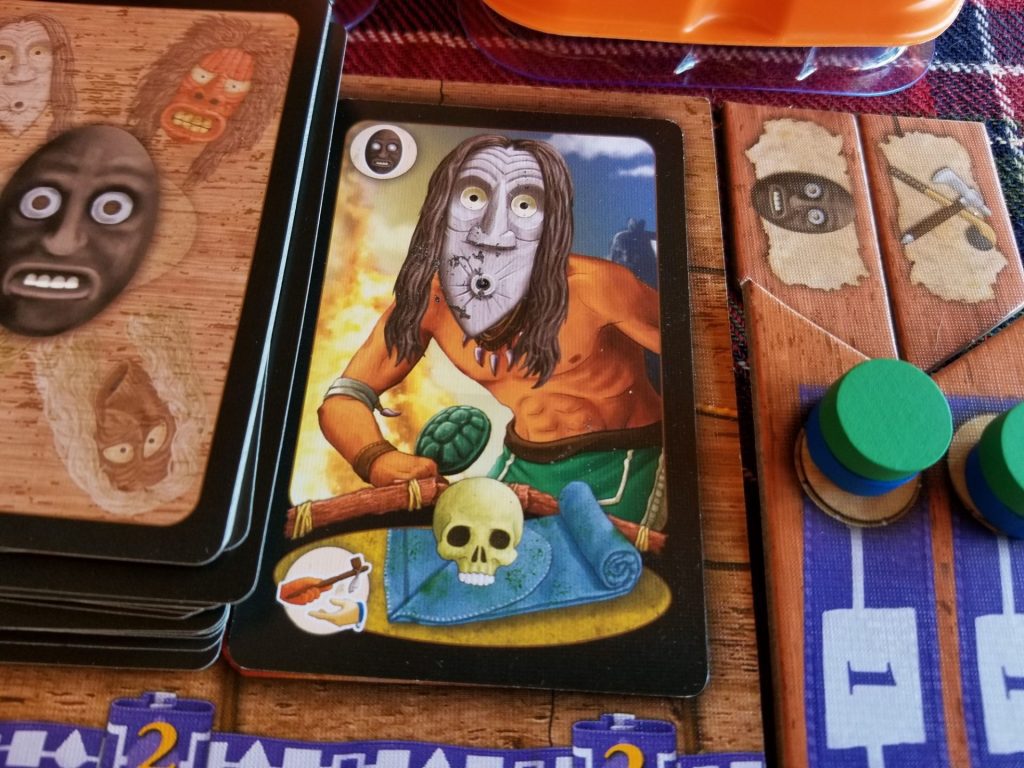
But the reality of smallpox during this time was no mild annoyance. Even before the settlers realized its power and weaponized it as a means of genocide, it spread like wildfire through the unprotected and unprepared native populations. While I am pleased that Wendake acknowledged that smallpox was something that really happened, the almost negligible penalty that it imposes feels like it underscores the message. Is this mechanic really needed? Should the game have sacrificed historical reality for the sake of enhancing the gameplay by leaving out the smallpox entirely? Should the penalty imposed by the smallpox blankets have been ratcheted up to better reflect the sobering reality?
I cannot answer these questions satisfactorily. It’s dangerous to ignore the lessons learned from history. At the same time, nobody wants to play a game that simulates misery and death on a large scale. Since I’m asking these questions and thinking about the history while simultaneously thinking about playing the game again, though, I suppose the game has succeeded in striking a balance of sorts. I applaud Danilo Sabia for his efforts. It’s never easy tackling issues like these and I’m glad it wasn’t me that had to tackle them. Were I to have designed this game, I probably would have left the smallpox blankets on the cutting room floor. It takes a certain kind of bravery to leave that mechanic in and risk the wrath of your audience.
Aside from that thematic issue and the way the rule book asks the players to place their natives into their longhouses grey side up without ever explaining why (a detail that comes up every time I play the game that I finally found the answer for after some internet sleuthing), I have nothing but high praise for Wendake. Its interesting mixture of different mechanics (specifically the asymmetric scoring tracks and the actions falling off of the player boards) creates an experience that manages to feel both familiar, yet distinctly unique every time that you play it.
The asymmetric scoring reminds me of Stonemaier Games’s Between Two Cities (and by extension Between Two Castles of Mad King Ludwig). Just as leaving a city/castle underdeveloped in one of those games will leave you with a low score, the same is true for the scoring in Wendake. But Wendake takes that pressure and multiplies it by doubling the scoring pairs. It’s the gameplay equivalent of simultaneously constructing 4 different cities/castles at a time in the previously mentioned games. While it’s not impossible to get high scores on all 4 scoring tracks, it’s very difficult to do so. It’s going to take a lot of forethought and planning. It’s going to take some sound decision making. And it’s going to take a little bit of luck.
I think this is ultimately what speaks to me the most about Wendake. I like playing games that pull me in a hundred different directions and force me to strategize on the fly. There’s just something undeniably pleasurable about solving a good puzzle and that’s ultimately what Wendake is: an efficiency puzzle. However, it’s not a puzzle that I find myself wanting to solve very often.
Even though the random pairing of scoring criteria and the ever changing nature of the player board do give each new game an element of uniqueness, the destination is the same and the journey to that destination is always somewhat of a slog. You feel good when you arrive, but you kind of dread it before you get started. Setting up the game is onerous. Teaching the game to new people feels like a chore. The game play never moves along as quickly as you hope it would. Even the tear down can feel a little soul-crushing.
For these reasons, Wendake isn’t a game that makes it to the table very often. But when it does, it’s universally an enjoyable experience. Everyone feels challenged. Nobody feels like their time has been wasted. Everyone has fun. If that sounds good to you, give Wendake a try. You just might be surprised.


